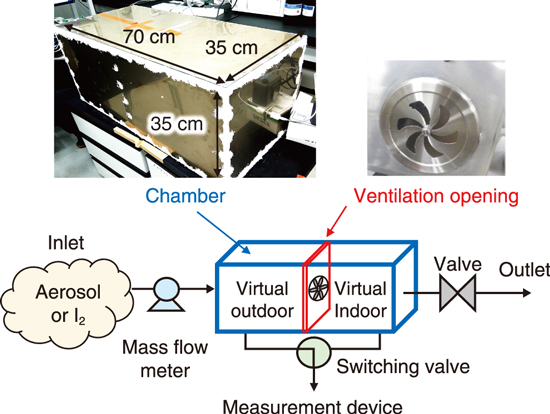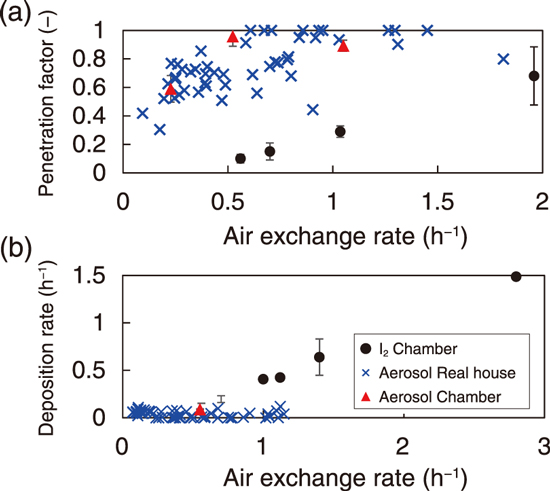
Fig.2-10 Diagram of chamber experiment

Fig.2-11 Penetration factor (a) and deposition rate (b) in relation to air exchange rate
Sheltering is one of the countermeasures for protection against residents' exposure in nuclear accidents. The indoor radioactivity concentration is calculated mainly with (1) the “air exchange rate”, which represents the ratio of indoor volume exchanging per unit time, (2) the “penetration factor”, which represents the ratio of radioactive materials entering the house without adhering to openings, and (3) the “deposition rate”, which represents the rate of radioactive materials adhering to walls and floor surfaces.
Iodine is one of the most important nuclides for internal exposure in the early stage of nuclear accidents. The form of iodine discharged into the atmosphere can be categorized into three types depending on its chemical properties and behavior: (1) iodine attached to aerosols (particulate iodine); (2) gaseous elementary iodine (I2); and (3) gaseous organic iodine (e.g., CH3I). The penetration factor and deposition rate differ among these forms, and the sheltering effectiveness depends on the proportion of each form. However, little is known about I2, and these parameter values depend on the material of the floor surface and openings. Since house characteristics differ among countries, it is inappropriate to apply the parameter values of foreign countries to assess sheltering effectiveness in Japanese houses; therefore, it is necessary to provide the parameter values for Japanese houses.
In this study, experiments were conducted in real Japanese houses (real house experiment) to obtain the penetration factor and deposition rate in Japan. Due to the toxicity of I2, its penetration factor and deposition rate was obtained only by experiments in a chamber simulating air exchange (chamber experiment). For particulate iodine, both experiments were conducted to examine the applicability of the chamber experiment results to real houses. The behavior of particulate iodine was assumed to be the same as that of other aerosols with the same particle size, and the values obtained using aerosols (NaCl) of 0.3–1 μm were used as the values for particulate iodine. This size is the same as that of particulate iodine observed during nuclear accidents. In the real house experiment, the penetration factor and deposition rate were determined by continuously measuring the aerosol concentrations indoors and outdoors. In the chamber experiment, these parameters were determined by alternately measuring the concentrations inside and outside the virtual room using a chamber separated in the middle by a ventilation opening (Fig.2-10).
The experimental results are shown in Fig.2-11. The penetration factor of aerosols and I2 are 0.3–1 and 0.15–0.7, respectively, with I2 being smaller, indicating that I2 is less penetrate than particulate iodine. The deposition rate of aerosols and I2 are 0.007–0.2 h-1 and 0.2–1.5 h-1, respectively, with I2 being larger, indicating that I2 is more easily deposited on surfaces than particulate iodine. Except for the deposition rate of aerosols, the values tended to increase with the air exchange rate.
The results of this study indicate that penetration factor and deposition rate differ between aerosols and I2, prompting the need to assess the sheltering effectiveness according to the proportion of each form. In the future, the sheltering effectiveness in Japanese houses using these values is planned to be assessed.
A part of this study was conducted in FY2020, supported by the Nuclear Regulation Authority in Japan.
(Jun Hirouchi)